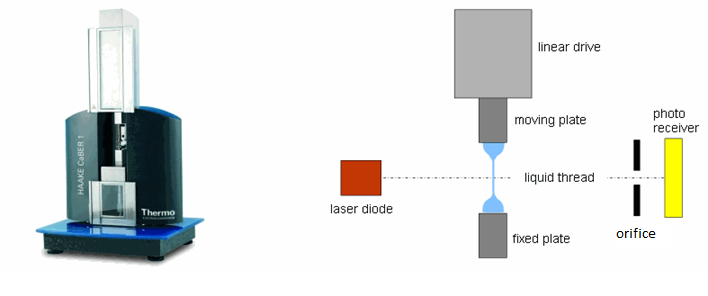CaBER (Capillary Break-Up Elongational Rheometer)
Objective
Numerous technical processes (e.g. filtration, pumping, spraying and other coating operations) include complex flow fields with strong elongational components. For non-Newtonian fluids, especially complex formulations like coatings and inks, adhesives, pharmaceutical, cosmetic or food products and very recently, biological materials, it is not possible to predict the elongational flow behavior merely from shear experiments. Consequently, a number of different techniques have been specifically developed to characterize the elongational flow of low-viscosity fluids and to predict their processing and application behavior. Among these techniques the CaBER method offers features such as simplicity and applicability to a wide range of fluids and it has been successfully utilized e.g. to study the atomization of polymer solutions or the runnability of paper coating colors for newly developed coating technologies.
Operating Principle
Our experimental set-up is based on a commercially CaBER1 (Thermo Fisher Scientific) device. A fluid droplet initially placed between two metal plates is exposed to an extensional step strain thus forming a liquid filament. Subsequent necking of that liquid bridge is controlled by the balance of capillary and visco-elastic forces. Deformation of a fluid element at the axial midplane of the bridge is purely uniaxial. Large extensional strains are attained as the filament necks down and finally breaks. In certain cases the extensional viscosity of the fluid can be calculated from the surface tension and the temporal change of the midpoint diameter, which can be monitored using a laser micrometer. But generally, neither stress nor strain rate are constant throughout the experiment and the calculated data are mostly transient and/or apparent values. Filament life-time and maximum drawability are other material-specific parameters that can be extracted to characterize elongational flow behavior. A deeper analysis of the experiment requires the time evolution of the filament shape over its entire length. Therefore, our set-up includes a high-speed camera (Photron FastCam-X1024 PCI) and an appropriate objective and filament illumination. This allows us to determine filament diameters down to 7 µm at a rate of 1000 frames/second (fps).

Fig. 1 Measurement instrument and schematic presentation of the operating principle
Specifications
The CaBER method is suitable for low viscosity fluids. Newtonian fluids with shear viscosities higher than 70 mPas can be measured by the CaBER method, whereas for viscoelastic fluids shear viscosities as low as 10 mPas can still be handled.
|
Maximum stretch rate: |
Hencky strain up to 7 depending on fluid |
|
Typical elongation rate: |
1 – 10 s-1 |
|
Required sample quantity |
ca. 1 ml |
|
Temperature: |
room temperature (21°C) |
|
Camera specifications: |
Highspeed cameras: FastCam–X 1024 PCI, Photron 1000 fps at 1024x1024 pixels, 2000 fps at 1024x512 pixels, 3000 fps at 512x512 pixels, up to 109500 fps at 128x16 pixels CMOS-Camera MC1302, Mikrotron max. 100fps at 1280x1024 pixels CCD-Camera AVT Pike F100B, Allied Vision Technology max. 60 fps at 1000x1000 pixels unlimited data acquisition Nikon 1V2 single pictures with high resulotion (14,2 millionen pixels) |
Applications
- Spray painting,e.g. in automotive industry
- Spraying of emulsions and lotions
- Filament spinning from polymer solutions
- Film split
- Curtain coating
| a) Typical Viscoelastic Fluid | b) Fluid with Apparent Yield-Stress |
Fig. 2 Different filament profiles during elongation of water-soluble polymer solutions with different polymer structure (double click on picture to start the video)
Literature
Capillary Break-up Rheometry of Low-viscosity Elastic Fluids,
L.E. Rodd et al., Appl. Rheol. 15, 12-27 (2005)
The Influence of Extensional Properties on the dewatering of Coating Colors,
J. Jäder, N. Willenbacher, G. Engström, and L. Järnström, Journal of Pulp and Paper Science, 31(4), 181-187 (2005)
Elongational Flow Behavior of Automotive Coatings and its Relation to Atomization and Mottling,
T. Dirking, L. Boggs, and N. Willenbacher, Progress in Organic Coating 42, 59-64 (2001)


